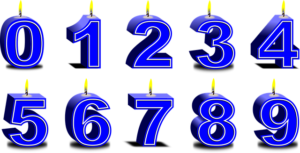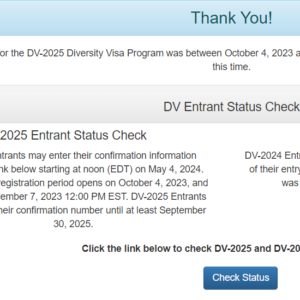Understanding Diversity Visa Case Number

Perhaps the second most important piece of information included in a Diversity Visa selectee’s letter of selection – after the clause “you have randomly been selected” – is their case number. So what in essence is case number? How is it determined? What is its importance? . . . among others, are questions this article provides answers to. Let’s begin by explaining what a Diversity Visa case number actually is.
What is case number in DV Lottery, and how is it determined?
Diversity Visa case numbers actually come about during the selection process. Entries submitted during the DV Lottery are first grouped according to region. Then during the selection process, the entries in each group (region) are randomly assigned consecutive numbers by a computer system.
Said numbers remain ‘attached’ to the entries up to the end of the selection process. Entrants who end up not being selected in the process never get to know their assigned number.
Those on the other hand who are eventually selected get to ‘discover’ their assigned number in their letter of selection. It is this ‘assigned number’ from the selection process which eventually becomes – and is henceforth referred to as – the Diversity visa selectee’s case number.
The Result?
This reality generally results in nonconsecutive case numbers in each region. For example, in a given region, you may have the initial case numbers to be 5, 7, 8, 9, 13, 18, 20, etc. Meaning the missing numbers are actually the case numbers of entries which happened to not have been selected.
This indicates that having a case number like 20 from our example above does not mean that there are 19 cases before yours. Usually, there are far fewer cases than that. How many cases there are before your case depends on the number of entries with case numbers lower than yours that were actually selected during the selection process. If during the selection process for example, 12 cases with case numbers lower than yours were selected (the rest not being selected), then there will be 12 cases before yours after the results are published.
Regional Case Numbering Systems
It is worth noting that a case number system exists by region, with each regional numbering system different from the other, owing largely to the number of entrants the regions provide during the Lottery. The higher the number of entrants a region usually provides, the more extensive its case number range; and vice-versa.
For example, the Africa region which usually provides the highest number of entrants to the DV Lottery (see chart) has the most extensive case number range (extending up to more than 100,000 in some years). And North America (comprising only one country) which accounts for the lowest number of entrants every year has the least extensive case number range (the highest being low double digits); etc.
Case Number Length and Comparison
The case number range of a region determines the length of the highest case number in that region. The highest case numbers in regions with less extensive number range comprise few digits, while those in regions with more extensive ranges comprise more digits – not counting the initial zeros. That is why the highest case numbers from regions such as Africa, Europe and Asia are longer than those from North America, South America and Oceania.
It must also be noted that case numbers can only be ‘compared’ within the same region and not across regions. What is considered a low case number in one region may be a high one in another region; and vice-versa.
Case Number Composition
Just by observing, you’ll realize that a case number comprises four parts. The first four digits are the program/visa year. That is, the fiscal year in which the selectee is eligible to apply for a Diversity Visa. Those four digits are followed by a two-letter abbreviation of the selectee’s region, then a number of zeros introduced to ensure that the case number has the same number of digits as others (8 digits); and finally the actual case number.
An example is 2021AF00007506, where 2021 is the visa year; AF is abbreviation for the Africa region; then the ‘intervening’ zeros; and 7506 is the selectee’s actual case number.
Note: When signing the DS-260 to submit it, the applicant is required to enter his/her case number without the preceding zeros. Failure to follow said instruction leads to an error message, thus preventing the form from being submitted.



Good afternoon. My case number is 2024SA50xx. I would like to know if is high?? Thanks
Yes, it seems to be.
My case number is 2024SA5059? Is really high??? Thank you
Yes, it seems to be.
Hello, my case number is 2024EU29xxx, is this a high case number? What are my chances for interview?
1. No, it’s not.
2. It will largely depend on your embassy.
hi i am a DV 2024 winner and my case No. is AS32300 from Bhutan.Is my case No. really high and any hope of being schedule for an interview.i would appreciate if you could enlighten on my case no…. thank you
1. No, it’s not really high.
2. That will largely depend on your embassy.
Hie
Here is my confirmation number 20236O9UW5A2BB6F
Should I use the same as my case number??
No. That was for entering the Lottery. You only get a case number if you are selected in the Lottery.
Hello
I’m a selectee for the DV2024 with a case number AF76324.
Did i stand a chance for interview?
Thank you
Yes, you do.
Hello
My case number is 2024AS21***.I’m from Iran
Is it high risk?Is it high number for interview??
No, it’s not.
Thanks but For 2023, only up to 16,000 case number from Iran were invited for interviews😔
Hi Im in the USA. I won the DV 2024. This is my case number. 2024SA000053xx. Do I need to submit DS-260? I have a status in the US. Is it high?
Sorry the question is incomplete.
Hi would you please tell me about my case number which is 2024AS14***
Is it good? Do you know which embassy should I choose between UAE , Turkey or Armenia?
1. Yes, it’s good.
2. Can’t tell as I don’t know your personal circumstances.
Hello, my case number is 2024AS37xxx, is this a high case number? is there a reasonable chance to be called for an interview?
1. To some extent
2. Yes.
how about AF00063K?
Which program?
Hello, my case number is 2024AS42xxx. I am currently in the US.
Is this a high case number? I submitted DS-260
Thank you!
Yes.
Hi my case number is 2024OC36xx. Is that considered high for DV2024? Appreciate the guidance!
High to some extent.
my case no is 2023OC2635
is it high number to be chosen for interview
Yes, it is – for the DV 2023 Program.
High my case number is around 18000 , do I have a good chance for interview?
Yes, you should.
My case num is 2024AS10XXX..I m frm Nepal…is it high case number..
No, it’s not.
Hello. My case number is 2024EU444XX.
Is it high case number?
Relatively high.
Hi my case number is 2024AF0009XXXX
Is it high
It’s relatively high.
Hi ,my case number is 2024AS16xxx
Is it a high number to be interviewed?
No,it’s not.
My case number is 2024AF00030XXX.
Is there need to be hopeful for an interview?
It will largely depend on the assigned embassy.
I live in the U.S.A. and my case number is 2024AF00081XXX is it high risk ? and they haven’t sent me an email yet! but I prepared the I-485 application and the documents, what can I do? thanks
It’s risky to some extent. Your case number has to become current in order for you to submit your application – which is not expected to happen soon in the 2024 fiscal year.
hello my case number is 2024EU00064xxx, I would like to know if the case number is high or I have a chance?
Thank you
It’s high, but some high case numbers still have a good chance these days. (I’ll elaborate on that in an article soon.)
2024EU54XXX is my case number. This is my first year that i applied and i was selected. I just don’t know what the chances are under this number.
Your case number seems to be a high one. However, as things currently are in the DV program, it is not the only factor that determines your chances. As a result, your chances can not be predicted at the moment. See this article for more insight: https://mydvprogram.com/dv-2023-when-will-i-be-interviewed
Hi, would case number 2024AF39××× be considered as a risky or high case?
No. For DV 2024, it wouldn’t.
hello my case number is 2024AF0010xxxx, want to know if the case is high.
Yes, it is high.
Hello,my case number is 2024EU00047xxx
Is it a high number to be chosen for an interview?
Thank you!
No, it is not – in the case of DV 2024.